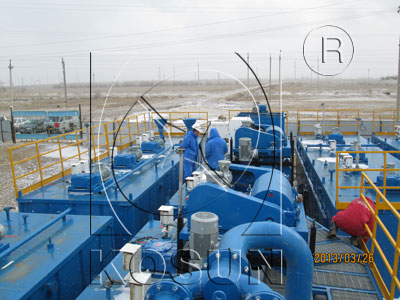Pad drilling has improved efficiency in handling and disposing of solids
2013-10-16
“The drilling fluid is then further processed, using low-speed and high-speed centrifuges to recover Barite and to further remove drill solids. These drill solids are also placed in the holding tank for disposal,” Mr Geng explained.
For land operations, the process is usually a closed-loop, or zero-discharge, system where the dry cuttings are held until they are transported to an offsite disposal facility or injection site, or they are solidified, based on the regulations of the area.
In a water-based mud operation, the use of a closed-loop system may be required. In this situation, the drilling fluid and cuttings are processed with a coagulating agent and a high-speed centrifuge to improve the separation of the solids. The remaining water is put back into the mud system. Depending on regulations, the cuttings are left on location or transported to a disposal facility.

Pad drilling also has improved efficiency in handling and disposing of solids. “With pad drilling, we have one road and one solids control catch tank for one area, serving anywhere from four to 30 wells,” Mr Geng said. “So we have less transportation and lower emissions, and we use less fuel and have fewer accidents.”
Determining which, and how much, equipment to utilize is examined on a case-by-case basis and is greatly determined by environmental regulations that govern the location of the operation and dictate how the cuttings are to be disposed of.
“Oil-based cuttings may involve more drying equipment,” said Dennis Welch, performance services manager, Newpark. “That can be cost-effective at the beginning phase of a well, when we’re drilling bigger holes and we have more cuttings,” he noted. “But when we get down to production holes on wells, where we are generating a lot less waste, we have to weigh the costs and the benefits. We don’t want equipment that is sitting idle, not paying for itself. When possible, we set up an open-top catch tank with a backhoe and try and recycle the liquids back into the circulating system and put the cuttings in dump trucks for disposal.”
“The higher the cost of trucking and disposal, the more attractive the equipment becomes. If there is a disposal site fairly close that charges a reasonable price, then we can reduce the amount of processing equipment on site,” Mr Geng said.
Because inland water is all zero-discharge regardless of the mud type, the cuttings are dumped to barges. “We try and have good solids control equipment, shakers and recycle pumps,” Mr Welch said. “We try to reclaim the usable fluids back out of the barges, and then everything is tugged to a collection facility.” The waste is taken from the barges to trucks, which haul it to a subsurface injection site.
But the industry is also looking at new techniques that are cleaner and more streamlined to deal with larger holes and faster drilling, which produces more solids and mud.
“On the rig, the trend is toward larger equipment, such as centrifuges, that can handle greater flow rates and remove more solids, especially the smaller solids, from the mud and keep it cleaner,” said Feng Geng, global product line manager, National Oilwell Varco.
News
- 07-11Technical features of using KOSUN drilling waste mud treatment system
- 07-07Main equipment of solids control system in drilling
- 06-26Geothermal well mud treatment system manufacturer—KOSUN solid control
- 06-26The key to achieving mud zero discharge is on-site processing after solid-liquid separation
- 05-10Application Scenarios of KOSUN Drilling Waste Treatment Equipment
- 05-10Environmental protection new regulations require to achieve zero discharge of drilling waste
- 05-09KOSUN Solid-liquid Separation Equipment is used in the construction industry
- 04-19What are the main functions of the Mud Agitator during use?
- 04-15The Advantages of KOSUN's trenchless horizontal directional crossing mud recovery system
- 03-15Vacuum degasser is mainly divided into centrifugal degasser and jet degasser




